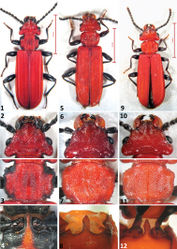Cucujus tulliae
| Notice: | This page is derived from the original publication listed below, whose author(s) should always be credited. Further contributors may edit and improve the content of this page and, consequently, need to be credited as well (see page history). Any assessment of factual correctness requires a careful review of the original article as well as of subsequent contributions.
If you are uncertain whether your planned contribution is correct or not, we suggest that you use the associated discussion page instead of editing the page directly. This page should be cited as follows (rationale):
Citation formats to copy and paste
BibTeX: @article{Bonacci2012ZooKeys212, RIS/ Endnote: TY - JOUR Wikipedia/ Citizendium: <ref name="Bonacci2012ZooKeys212">{{Citation See also the citation download page at the journal. |
Ordo: Coleoptera
Familia: Cucujidae
Genus: Cucujus
Name
Cucujus tulliae Bonacci & Mazzei & Horák & Brandmayr, 2012 sp. n. – Wikispecies link – ZooBank link – Pensoft Profile
Type locality
Italy, Central Calabria, Sila National Park, mountains between the Cecita Lake and the Longobucco municipality, 1300–1600 m a. s. l., forests between 39°23'/25'N and 16°32'/35'E.
Type material
Holotype male: Sila National Park, Calabria, Italy, Vallone Freddo, Spezzano Sila (CS), 1300 m a. s. l., larva collected at instar five 18.10.2010, lg. Mazzei, adult emerged 28.12.10 in laboratory, prep. N. 3, PBC. Paratypes: one female, Vallone Freddo, reared from an aged larva collected 05.04.2011, lg. Mazzei, PBC. Larval specimens: 12 larvae (III–VI instar), Calabria, Sila, Vallone Freddo, Spezzano della Sila (CS), 1300 m a. s. l., lg. Mazzei, 05.05.2011; 2 larvae (V–VI), Calabria, Sila, Golia Corvo Natural Reserve, Spezzano della Sila (CS), 1300 m a. s. l., lg. Bonacci; 15.07.2011; 1 larva (V), Calabria, Aspromonte, Gambarie (RC), 1350 m a. s. l., lg. Mazzei, 07.06.2009.
Etymology
Tullia Zetto was an active zoologist and teacher of the Department of Ecology of the University of Calabria, who endeavoured for more than 20 years larval morphology and behaviour of carabids and other predatory beetles in Calabria and in several Mediterranean lands. She was born in Trieste 15.01.1949 and deceased in Cosenza 24.11.2010.
Diagnosis
Cucujus tulliae is clearly related to the cinnaberinus–haematodes species group, its distribution seems to be restricted to the mountains of Calabrian peninsula. The closest taxon could be Cucujus haematodes, from which it can easily be distinguished by the less prominent postgenae, the arrow head shaped prosternal apophysis, the smaller and less spiny pronotum, the typical median lobe of the aedeagus and the larval morphology, that is apparently unique because of its slender body and occipital furrows.
Description
A bright red species, resembling a small–sized haematodes in colour, but with a less serrate pronotum. Length 11.2–12.5 mm. Colour light red, legs dark brown/black, tarsi brown. Prosternum of the same colour of pronotum. Antennae black, mandibles red/orange with black apex. Head distinctly wider than pronotum, with two longer setae after the posterior border of eyes. Postgenae less swollen than in Cucujus haematodes (Figs 1, 5, 9). Occipital furrow deep and long as one third of the posterior head width. Frontoclypeus with a gentle longitudinal swelling. Pronotum less spiny than in Cucujus haematodes, distinctly prolonged at the level of the neck as a short collar (Figs 3, 7, 11). Prosternal apophysis elongated as an arrow head, slender than in Cucujus haematodes (Figs 4, 8, 12). Elytral sides distinctly carinate at its upper external margin, almost until the apex. Elytral surface opaque, density of punctures similar to that of Cucujus haematodes. Apex of elytra broadly rounded and with short pubescence. Metathoracic wings well developed and robust. Sutural stria slightly convex. Median lobe distinctly wider than median strut, less restricted at its apex than in haematodes (Figs 13, 16, 19, 21).Apical process well protruding, more than in haematodes, and triangular at the tip, like in Cucujus cinnaberinus (Figs 14, 17, 20, 22). Median strut 4.5 times longer than median lobe and particularly thin. Flagellum longer than the entire body, connected at its base with the male deferents, its more chitinized trait reaches the median lobe at the level of the two chitinous plates of the endophallus and bends backwards to the median strut. After bending the flagellum becomes transparent and runs across the endophallus, where, at the middle of its length, it rolls up in a sort of “ball”, like a wire (Fig. 17). In figure 2 the “flagellum ball” is photographed in the median strut of Cucujus cinnaberinus (Fig. 18).
Distribution and habitat
The larvae of this species have been collected under the bark of fallen pine trees of at least 25 cm diameter or on dead silver fir fallen trunks, but only on single locations of the National Park. The species seems to prefer cooler, northern exposed slopes and high air humidity at major elevations. In laboratory most larvae kept at 20°C died before pupation, a fact that could be explained by lower temperature preferences of the immature stages. The low number of larvae collected and the successful rearing of only two adults makes hypothesis much more difficult. Concerning geographic distribution, at the moment this taxon is known only from Calabria, in the highest part of the Sila plateau in the core of the Sila National Park, from two sites: Vallone Freddo and Serra Vurga. A single larva has been collected in the surroundings of Gambarie, in the Aspromonte National Park, at 07.06.2009, but this specimen died before pupation. There is little doubt that this new taxon may be an endemic saproxylic beetle of central and southern Calabria, with larval populations depending on the availability of high amounts of dead wood, especially of Calabrian pine, Pinus laricio var. calabrica.
Original Description
- Bonacci, T; Mazzei, A; Horák, J; Brandmayr, P; 2012: Cucujus tulliae sp. n. – an endemic Mediterranean saproxylic beetle from genus Cucujus Fabricius, 1775 (Coleoptera, Cucujidae), and keys for identification of adults and larvae native to Europe ZooKeys, 212: 63-79. doi
Images
|

